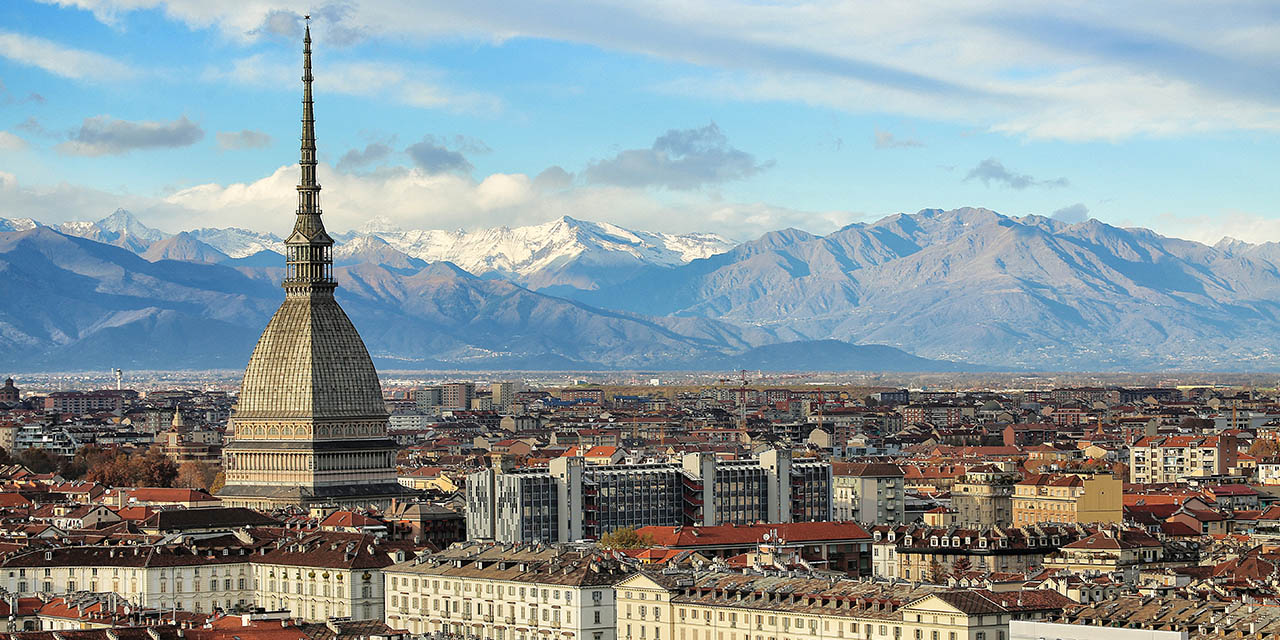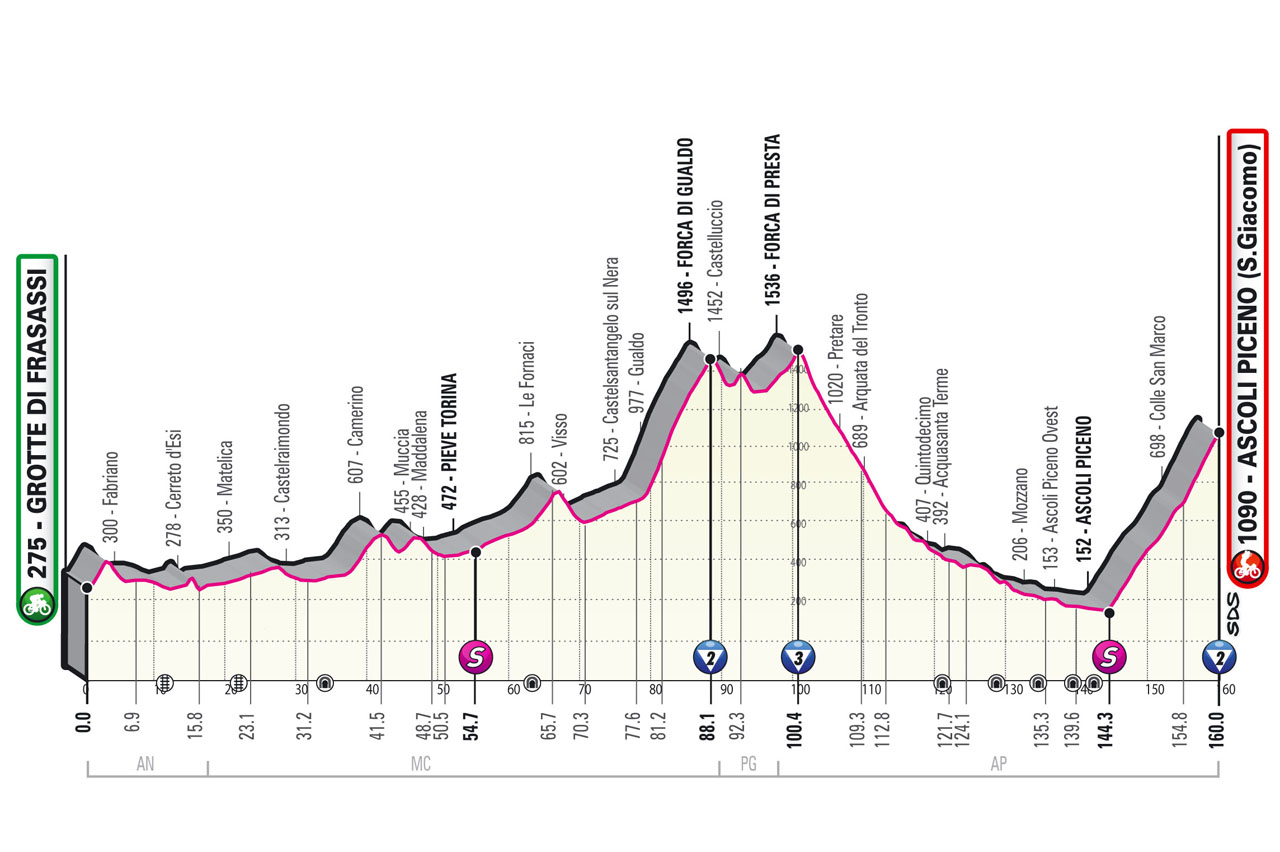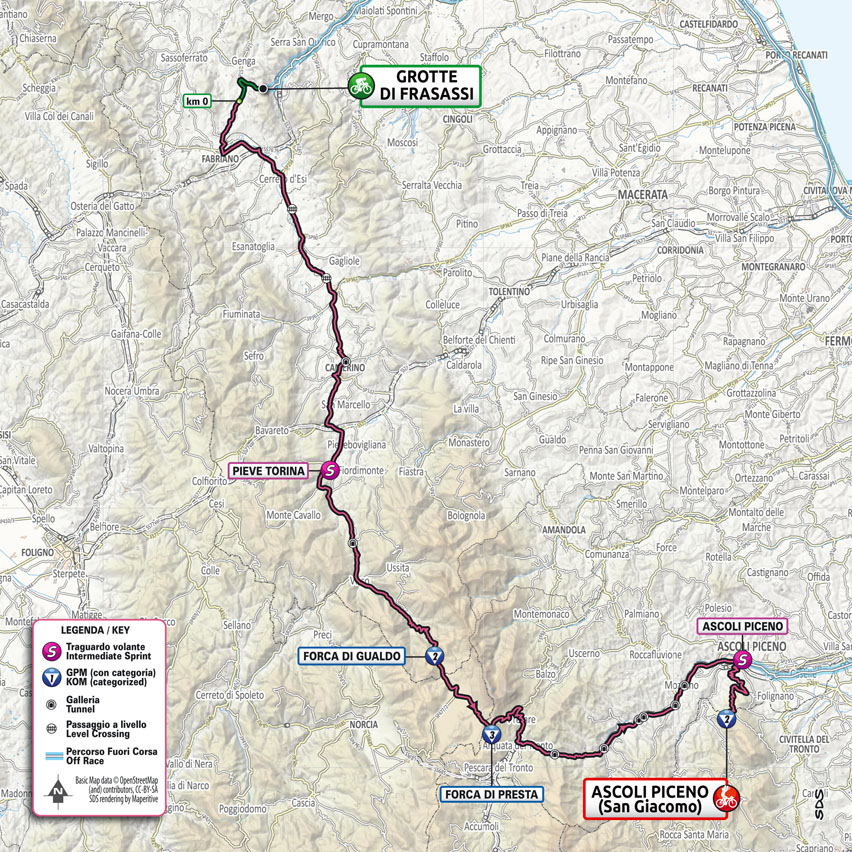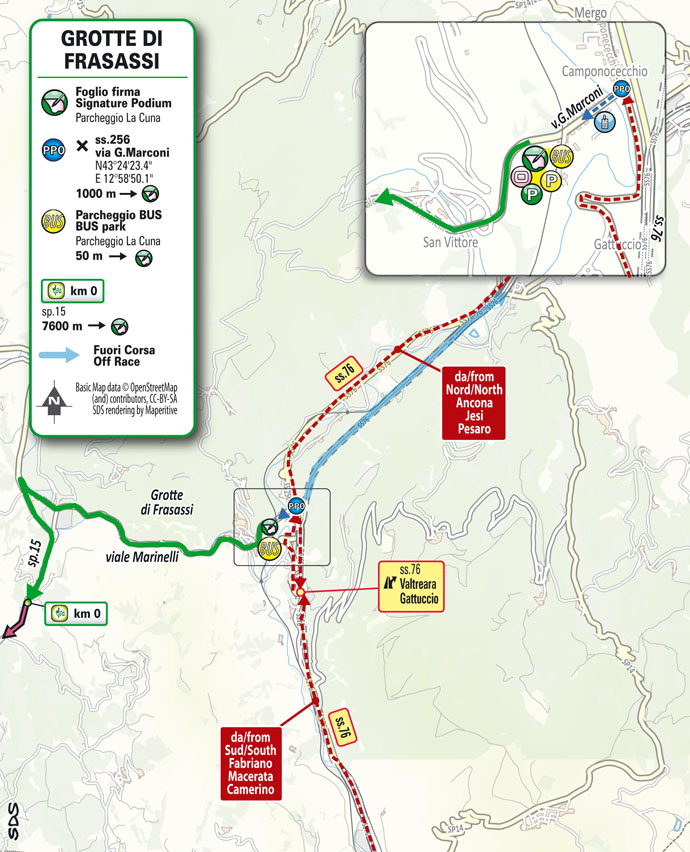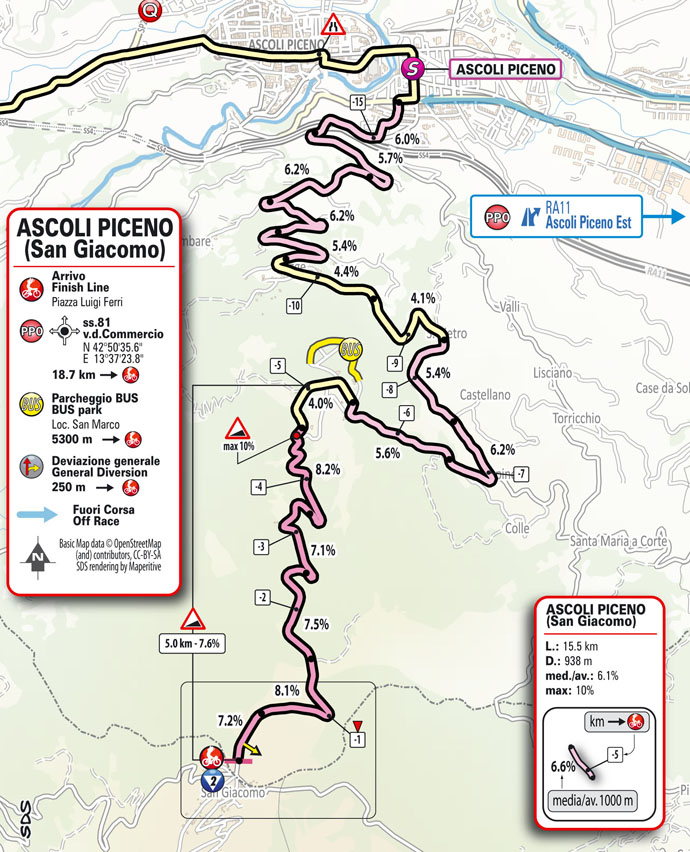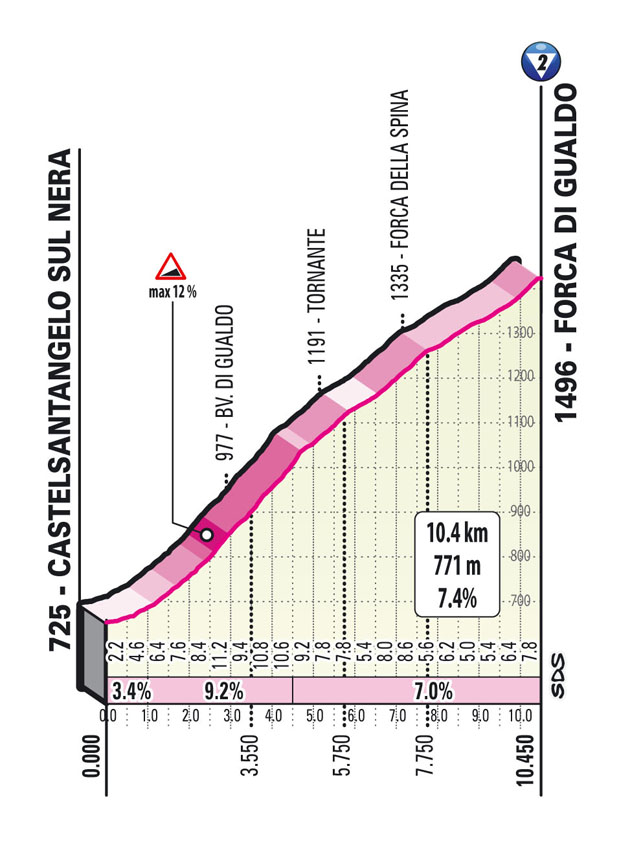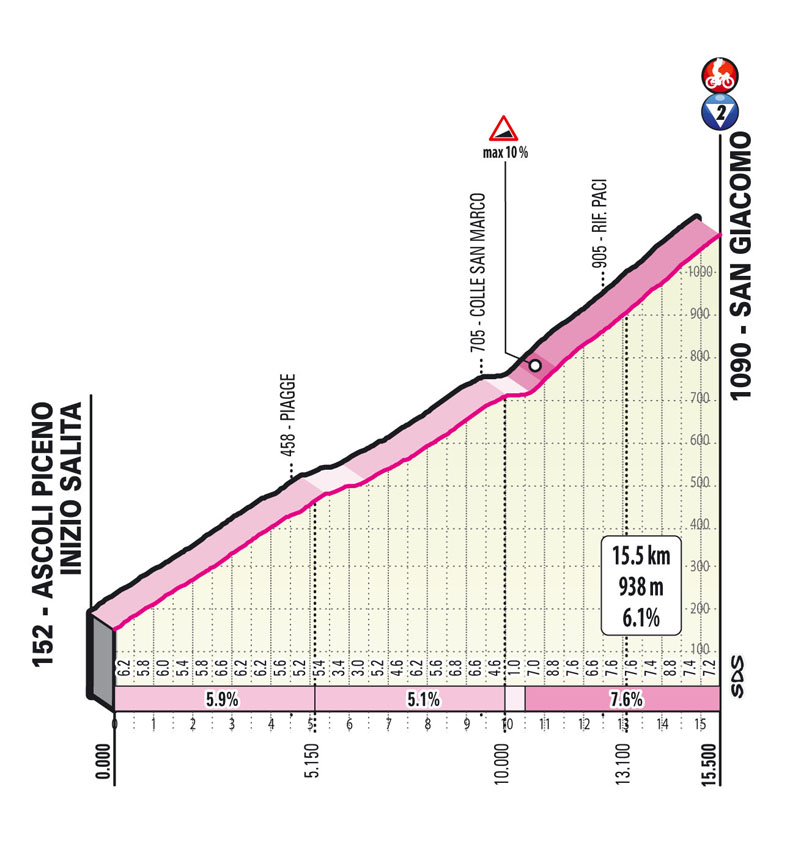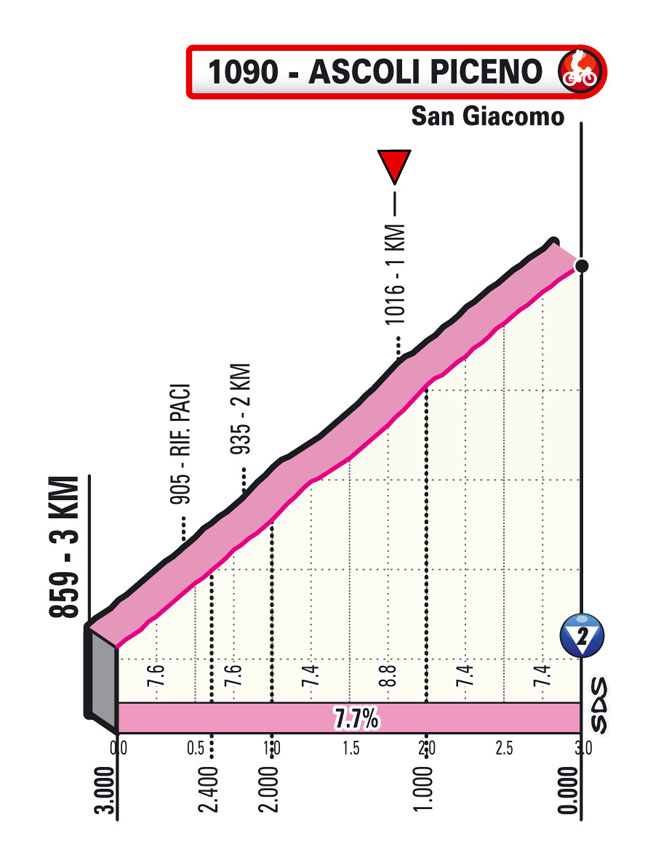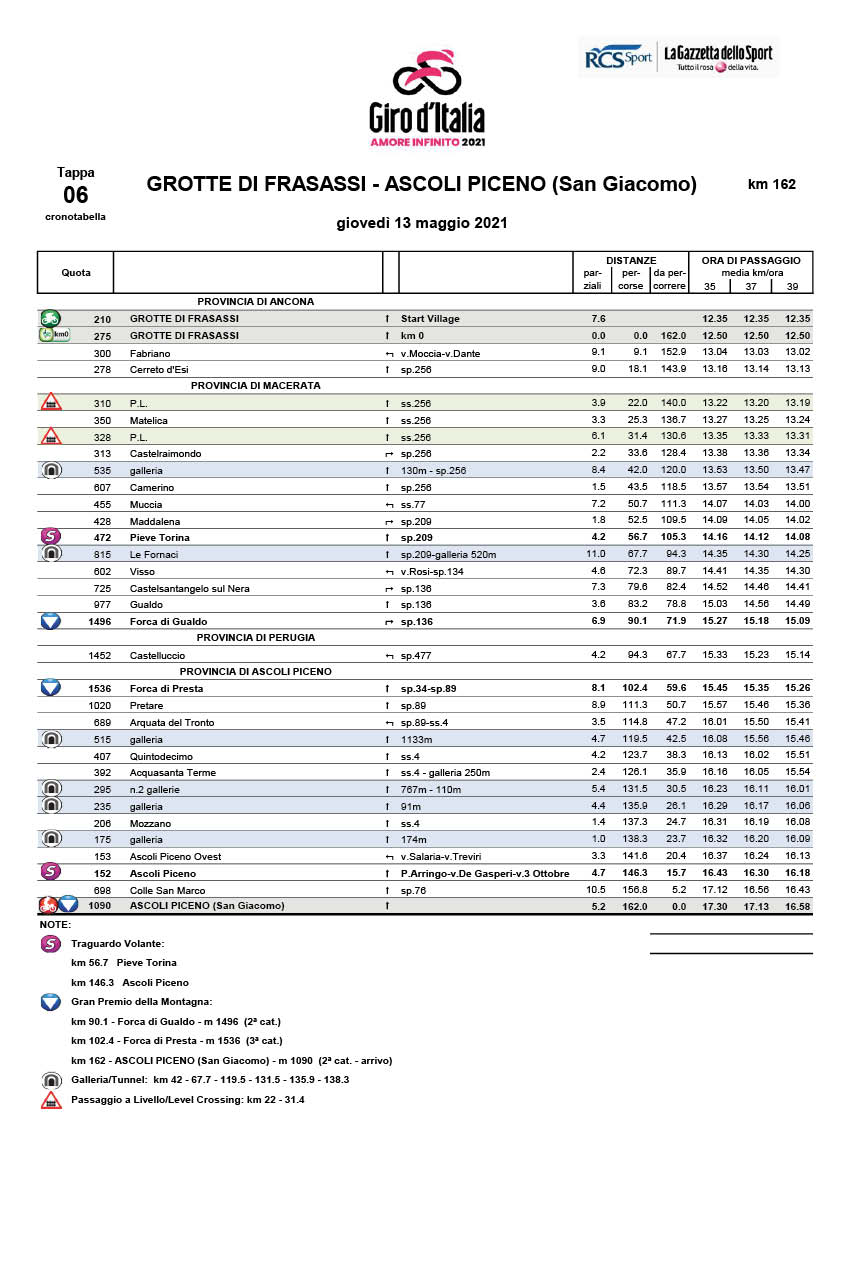profile
map
technical info
Running almost entirely through the inland, across the Apennines, the stage is demanding in both course and profile. The route takes in several ascents, including two categorised climbs. The main obstacles along the course are the ones typically found in urban areas. The final climb is approx. 15 km long.
Final kilometres
The final kilometres are entirely uphill. Past Ascoli Piceno, the route rises steadily at around 5% up to Colle San Marco, and continues with slightly higher gradients all the way to the finish, on tarmac road.
start / finish
climb detail
final kilometres
itinerary timetable
tourist info
Host city:
Grotte di Frasassi
Overview
The village of Genga is a small medieval castle built on the rock located in the heart of the Marche, along the pre-Appennine band a stone’s throw from the city of Fabriano in the province of Ancona. Recognized as the birthplace of Pope Leo XII (1760-1829), Genga owes its national and international notoriety to Frasassi Caves, destination every year of hundreds of thousands of tourists from all over the world. Inserted within the Gola della Rossa and Frasassi Regional Natural Park, its territory immersed in nature is a popular destination for hikers, climbers, speleologists and bikers.
From a historical and cultural point of view, it is possible to visit two fortified villages, those of Genga and Pierosara, as many museums and three places of worship, such as the Romanesque Abbey of San Vittore delle Chiuse, the Temple of Valadier and Sanctuary of Santa Maria Infra Saxa, both inserted in Cave of Blessed Virgin in Frasassi.
These peculiarities have freed the Municipality of Genga of the Orange Flag recognition, an Italian touring club tourist-environmental brand.
Gastronomy
The typical dishes and recipes of the area are one of the main attractions for lovers of culture and history of gastronomy. Genga is known throughout Italy for its long tradition of salami factories and norcinerie: a past ritual carried out today by the Salumificio di Genga.
Among the most appreciated gastronomic typicalities, in addition to the great variety of sausages and cold cuts, there is certainly porchetta cooked according to the ancient recipes handed down from generation to generation. Flavors of the time that can be tasted in the many trattorias and restaurants present in the area, where you can also taste dishes based on fine truffle, very widespread in the Genga and Fabriano area and based on game, including wild boar.
The traditional peasant cuisine is represented in particular by handmade pasta: right in Genga you can taste the typical pincinelle, a particular type of handmade pasta similar to rolled noodles. When it comes to homemade pasta, in the tradition of the Marche hinterland, the famous vincisgrassi present on the menu of many local inns can certainly not be ignored: a tasty variant of baked pasta or lasagna with origin dating back to the late 1700s seasoned with a rich meat sauce and served especially during the holidays or during Sunday family lunches.
Other delicacies to count are certainly the crescia, a typical focaccia cooked under the grill accompanied by cured meats, wild herbs or pork fats, the ciauscolo, a sausage typical of the peasant tradition, the snails and polenta, a dish often accompanied by wild boar sauce and protagonist of the Autumn Festival held in Genga at the end of October.
As for desserts, among the excellences of local gastronomy there is certainly the cicerchiata, a carnival dessert typical of the area and now widespread throughout the regional territory. The name cicerchiata has medieval origin and derives from the words “pile of cicerchie”, legumes similar to peas or chickpeas covered with honey. Another typical dessert of the local tradition also wrapped in an abundant dose of honey are castagnole, bullets of sweet fried pasta, which in fact constitute one of the tastiest specialties in the area. Finally, to include the crescia fojata, a thin puff pastry, stuffed with apples and dried fruit and rolled on itself.
Drinks
Frasassi extends into an area rich in karst complexes that constitute reservoirs for the water supply of most of the places present in the hinterland and along the coast of the province of Ancona. Its water, called Acqua Frasassi, for its purity and authenticity is also exported and marketed all over the world.
The internal area of the province of Ancona is then characterized by the presence of some typical vines of the territory. The proximity to the Jesini hills means that even in the Genga area the typical Verdicchio is widespread, a still white wine that today represents the symbol of Marche oenology. The first written testimonies on verdicchio date back to the 16th century. Verdicchio dei Castelli di Jesi is a DOC wine produced in the Marche region in the province of Macerata and Ancona. It has a straw yellow color not very loaded, with greenish reflections, on the nose shows delicate fruity aromas and typical floral scents, in the mouth it is dry and savory, with a flavor that sometimes slightly resembles that of almonds. The many wineries in the area offer tourists the opportunity to carry out tours and tastings. Not too far away there is also the city of Matelica where another variety of Verdicchio DOC is produced, much appreciated and widespread also in Genga. The difference compared to Verdicchio di Jesi is in the most acidic taste determined by a greater distance from the sea and the presence of a colder climate due to the presence of the surrounding mountains.
Another wine very well known and appreciated in the Genga-Frasassi area is the Lacrima di Morro d’Alba which is produced in the hills of Morro d’Alba in the province of Ancona: a Marche wine generated by lacrima grapes, a native vine of aromatic nature, with intense, unmistakable and unforgettable aromas once tasted, very versatile, suitable to produce wines both simple and light and more full-bodied and structured. It has a good predisposition to withering, being used both in the production of dessert wines, but also to soften the flavor in dry wines.
A last typical local drink is visciolino, a visciole liqueur, a variety of sour cherries, similar to cherries but smaller and sweeter and darker in color.
Main sights
The Frasassi location, so named for the presence of the gorge that separates rock formation in two impressive “stones”, hosts one of the most suggestive natural heritage in the world: Frasassi Caves. Discovered in September 1971 – this year marks the 50th Anniversary – they attract over 300,000 visitors from all over the world every year and represent an essential destination for school tourism. Between huge stalactites and stalagmites, the tourist trail stretches for about 1.5 km and offers the visitor a unique experience in the heart of the earth through a history of millions of years. For the most adventurous, there is also the possibility to face two speleological paths: armed with helmet, overalls and special harnesses, the speleological guides lead the visitor out of the traditional route, to discover cavities otherwise not to be visited. Once re-emerged from hypogea exploration, the territory of Genga offers tourists the opportunity to discover monuments, places of art, worship and devotion.
Enclosed between the walls of the medieval castle and native place of Pope Leo XII (1823- 1829), at the century Annibale of the Genga (1760-1829), Genga is headquarters today of the Municipality and the Consorzio Frasassi, an institution that manages the famous Caves. In addition to the churches of San Clemente and Santa Maria Assunta there is the museum “Art, History and Territory” which among the different works, hosts the
Madonna and Child, a sculpture attributable to the workshop of Antonio Canova, a
triptych by Antonio da Fabriano (15th century XV) and the Venus of Frasassi, a copy of a Paleolithic statuette, whose the original is preserved in the National Archaeological Museum of the Marche.
Along the throat of Frasassi, in the cave of the Blessed Virgin arise the Madonna di Frasassi Sanctuary, known as the Valadier Temple, inaugurated in 1828 by Pope Leo XII on the project by the architect Giuseppe Valadier and the Sanctuary of Santa Maria Infra- Saxa, an ancient Benedictine monastic hermitage, presumably before the 11th century.
In the village of San Vittore stands the Abbey of San Vittore alle Chiuse, an imposing Romanesque building with a Greek cross dating back to the 11th century in the process of being recognized as a UNESCO heritage site, with the adjoining Speleo Paleontological and Archaeological Museum, in which there is a fossil of ichthiosaur, a marine reptile that lived in the Mesozoic Era. In front of the church, a bridge whose stand of Roman origin is defended by a medieval tower.
Located in a strategic position close to the Gorges of Frasassi and Rossa, stands the Lombard castle of Pierosara, ancient Castrum Petrosum, which in addition to the churches of San Sebastiano Martire and the Blessed Virgin Mary of Graces, preserves the watchtower, the two access gates and the legend of Piero and Sara handed down to the present day.
Frasassi is also fun and discovery: in the area of San Vittore it is possible to entertain yourself at Frasassi Avventura, an acrobatic park that develops along the banks of the Sentino river, where between zip-lines and suspension bridges, you can live a unique experience of its kind.
For trekking lovers, the paths of the Gola della Rossa and Frasassi Park, including Foro
degli Occhialoni, Sentiero dell’Aquila, Sentiero del Papa and the Valle Scappuccia, offer the possibility of breathtaking excursions in the most panoramic and suggestive points in contact with the animal and plant biodiversity present.
Frasassi is also one of the destinations of mountain bikers who walk along the many dirt trails present, climbers who try their hand at the different climbing walls and speleologists in exploration of the many karst cavities that exist.
Finally, for wellness lovers, the famous Terme di Frasassi which represent an unmissable stop to enjoy, in well-deserved relaxation, the treatments reserved for personal care.











